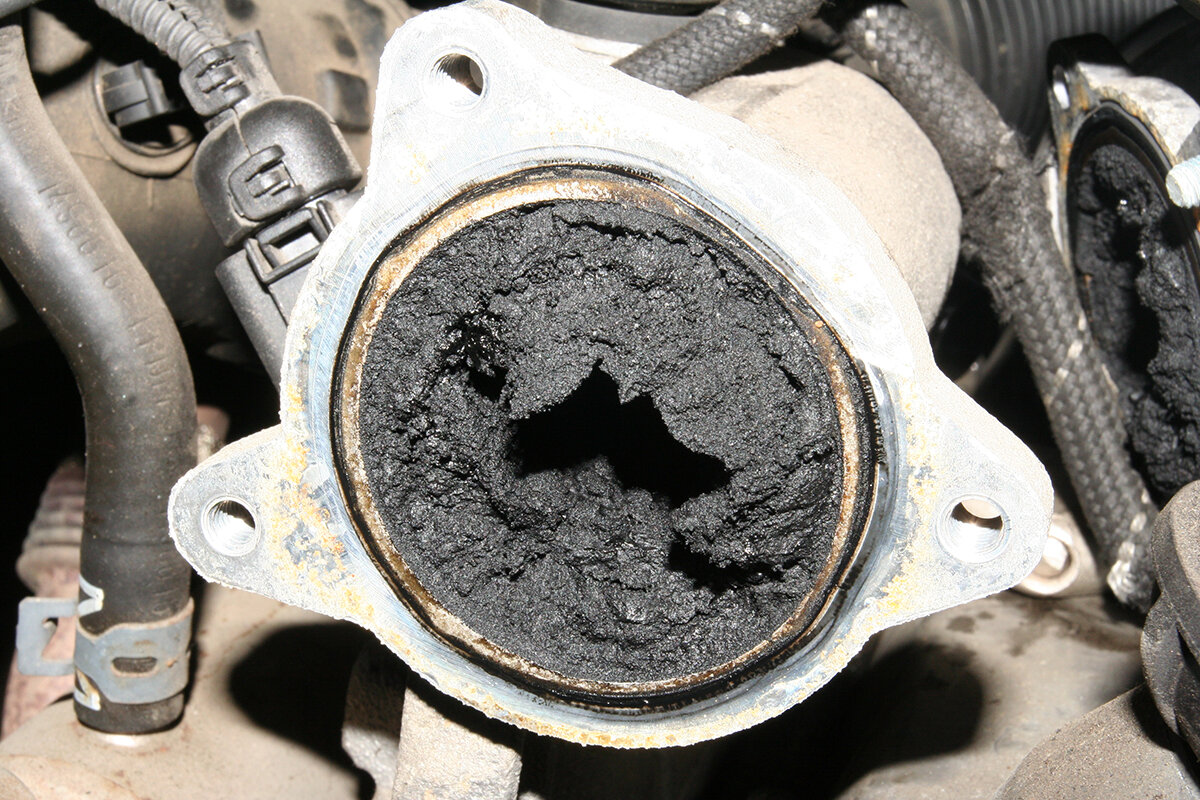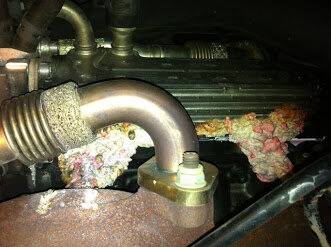Can a defective EGR valve cause coolant loss?
How the hell can a defective EGR valve cause coolant loss? Surely the dealer is bullshitting you over that. But maybe not…
This helluva good question comes from a dude named Brad - who seems to be one of us - whoever the hell ‘we’ are:
I’m seeking your advice after a friend's new Ford SUV was diagnosed for coolant loss by the Ford dealer. Can a leaking EGR valve cause coolant loss? If so, how and where?
- Brad
EGR stands for the ‘exhaust gas recirculation’, a system that pumps exhaust back into the inlet of your engine, at times, in measured doses.
Diesels do this more enthusiastically than petrols, but they both do it. And I know you’re thinking: pumping exhaust back into a perfectly serviceable engine sounds bad. Certainly it’s counter-intuitive, but in fact doing this actually improves fuel economy and also reduces toxic emissions, because: physics.
Short version: The EGR system is water cooled - it’s capturing hot, highly energetic exhaust gas from between the manifold, and sending it back to the inlet side of the engine, and that heat is a gross disadvantage to engine operation.
Therefore, water from the engine’s cooling system is pumped through the EGR unit, in a mini heat exchanger, whence it captures some of this heat before it gets to the EGR valve. That heat is ultimately rejected in the vehicle’s radiator, which is designed to stop some sort of mini, automotive Chernobyl.
Take a look.
Right up the top we’ve got a turbocharger: #01. The blue side is the inlet compressor - which pumps air into the engine. The orange side is the turbine driven by energetic exhaust gas flow. It’s a way of doing something useful with heat energy which would otherwise be wasted.
The zig-zaggy tube on the left (I know - it’s a big, scary technical word: ‘zig-zaggy’) - that is the intercooler: #02. Air gets hot when the turbo compresses it. That’s bad, in inlet air, so intercoolers are air-to-air convective coolers.
It’s like a ‘radiator’. Even though that’s completely the wrong word for the mechanism of heat loss that’s doing the work.
Then you’ve got your engine. Four cylinders in this schematic. Blue for inlet. Orange for exhaust. The EGR system taps into the highly energetic exhaust flow, just before the turbo. The actual EGR valve itself - which controls how much exhaust gets recirculated - is just there: #05.
But the bit we’re interested in is the EGR cooling system: #06. Which is right there and does a fairly miraculous job chilling things out, in relative terms.
Water gets pumped in, and as you may or may not know, water is practically the perfect heat transfer medium. 4.2 kilojoules - a substantial amount of heat - increases the temperature of one kilo of water by just one degree C.
So, just roughly, if you’ve got about 10 litres per minute circulating through the EGR heat exchanger and it goes in at 50 degrees C and comes out at 100 (it’s okay, it’s unlikely to boil because the system is pressurised) it’s removing about two million joules of heat energy every minute from the EGR system.
That’s, like, 35 kilowatts of heat rejection. That’s a lot. A 35-kilowatt raadiator would warm up a somewhat large room, even if it’s snowing outside.
The point being, a small amount of water can carry away a shit-tonne of heat energy. Because water is properly miraculous stuff.
Unfortunately the same miraculous property is what kills you quickly if you get rained on in the wilderness and it gets cold and windy, and you forgot the right clothing. So there’s that.
What happens…
If the EGR cooling system develops a leak, water can escape into the recirculating exhaust gas, and pass through the engine, and disappear out the exhaust pipe, with virtually no symptoms, except of course for gradual coolant loss, the cause of which can be hard to diagnose.
The loss is easy to identify. Where it’s being lost … not so much.
If that happens, the whole EGR body - which is typically one big stainless steel bolt-on component - needs to be changed out.
And that’s a relatively simple job.
I’m sure the dealership will attempt to take you to the ankle-grabbing room over it, but it’s really just a new EGR body out of a box, three or four bolts, a gasket and a couple of water hoses. Of course, some disassembly might be required to gain physical access to that area in the engine bay.
Repair bills are never uplifting. My advice there: Think about boobies. That always helps, even if you’re a chick. I’ve seen those movies.
(Pro Tip: Whatever you do, do not be one of those muppets who deletes, disables or modifies their EGR system like some do with their DPF. Not only is it illegal, it voids any statutory warranty you might have with that vehicle, and it only makes matters worse). Aftermarket modification is a minefield - don’t walk that line.
One viable solution is installation of a catch can. Learn more about that here >>
Result
In the case of on-the-fritz EGR, here’s your silver lining: Apart from obvious causes of coolant leaks, like hoses, most other engine coolant leaks are expensive to fix - I’m talking a blown head gasket or a defective turbocharger (they’re often water-cooled too), or (even more expensive) a cracked cylinder head.
So, given the choice, I think I’ll make mine a defective EGR valve. So, ERG can cause coolant loss. It’s a real thing, and Brad’s dealer is probably not bullshitting him - except maybe on the price.
HEADING
XXXXXXXXXXXXXXXXXXXXXXXXXXXXXXXXXXXXXXXXXXXXXXXXXXXXXXXXXXXXXXXXXXXXXXXXXXXXXXXXXXXXXXXXXXXXXXXXXX
XXXXXXXXXXXXXXXXXXXXXXXXXXXXXXXXXXXXXXXXXXXXXXXXXXXXXXXXXXXXXXXXXXXXXXXXXXXXXXXXXXXXXXXXXXXXXXXXXXXXXXXXXXXXXXXXXXXXXXXXXXXXXXXXXXXXX
XXXXXXXXXXXXXXXXXXXXXXXXXXXXXXXXXXXXXXXXXXXXXXXXXXXXXXXXXXXXXXXXXXXXXXXXXXXXXXXXXXXXXXXXXXXXXXXXXXXXXXXXXXXXXXXXXXXXXXXXXXXXXXXXXXXXXXXXXXXXXXXXXXXXXXXXXXXXXXXXX
XXXXXXXXXXXXXXXXXXXXXXXXXXXXXXXXXXXXXXXXXXXXXXXXXXXXXXXXXXXXXXXXXXXXXXXXXXXXXXXXXXXXXXXXXXXXXXXXXXXXXXXXXXXXXXXXXXXXXXXXXXXXXXXXXXXXXXX
XXXXXXXXXXXXXXXXXXXXXXXXXXXXXXXXXXXXXXXXXXXXXXXXXXXXXXXXXXXXXXXXXXXXXXXXXXXXXXXXXXXXXXXXXXXXXXXXXXXXXXXXXXXXXXXXXXXXXXXXXXX.XXXXXXXXXXXXXXXXXXXXXXXXXXXXXXXXXXXXXXXX
XXXXXXXXXXXXXXXXXXXXXXXXXXXXXXXXXXXXXXXXXXXXXXXXXXXXXXXXXXXXXXXXXXXXXXXXXXXXXXXXXXXXXXXXXXXXXXXXXXXXXXXXXXXXXXXXXXXXXXXXXXXXXXXXXXXXXXXXXXXXXXXXXXXXXXXXXXXXXXXXXXXXXX
XXXXXXXXXXXXXXXXXXXXXXXXXXXXXXXXXXXXXXXXXXXXXXXXXXXXXXXXXXXXXXXXXXXXXXXXXXXXXXXXXXXXXXXXXXXXXXXXXXXXXXXXXXXXXXXXXXXXXXXXXXXXXXXX
XXXXXXXXXXXXXXXXXXXXXXXXXXXXXXXXXXXXXXXXXXXXXXXXXXXXXXXXXXXXXXXXXXXXXXXXXXXXXXXXXXXXXXXXXXXXXXX.





















Toyota has raised the Corolla and called it a small SUV, one that offers reliability, practicality and even performance atop the range. Let’s see if there are any redeeming features that can justify the $50K price?